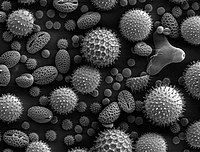
Photo from wikipedia
There is currently a need for new rapid viral diagnostic electron microscopy methods. Although the gold standard remains the transmission electron microscopy (TEM) negative staining method for electron microscopic examination… Click to show full abstract
There is currently a need for new rapid viral diagnostic electron microscopy methods. Although the gold standard remains the transmission electron microscopy (TEM) negative staining method for electron microscopic examination of samples containing a virus, difficulties can arise when the virus particle content of the sample that has to be examined is poor. Such samples include supernatants of virus-infected cells that can be difficult to examine, as sometimes only a few virus particles are released in the culture medium upon infection. In addition to TEM, scanning electron microscopy (SEM) can also be used for visualizing virus particles. One advantage of SEM over TEM is its ability to rapidly screen several large specimens, such as microscopy slides. In this study, we investigated this possibility and tested different coating molecules as well as the effect of centrifugation for analyzing SARS-CoV-2-virus-infected cell culture supernatants deposited on microscopy glass slides by SEM. We found that centrifugation of 25XConcanavalinA-coated microscopy glass slides in shell vials provided an improved method for concentrating SARS-CoV-2-virus-infected cell supernatants for virus-like particle detection by SEM.
Journal Title: Viruses
Year Published: 2022
Link to full text (if available)
Share on Social Media: Sign Up to like & get
recommendations!